Abstract
The cooked meat mutagen 2-amino-1-methyl-6-phenyl-imidazo[4,5-b]pyridine (PhIP) is metabolized in vivo to electrophilic intermediates that covalently bind to DNA guanines. Here we address the mechanism of PhIP's non-covalent interaction with DNA by using spectroscopic and computational methodologies. NMR methodologies indicated that upon addition of DNA, PhIP aromatic protons underwent a small, 0.11-0.12 p.p.m. upfield shift. DNA phosphorus resonances of non-covalent PhIP-DNA complexes broadened and slightly shifted upfield, while DNA base imino proton resonances shifted slightly downfield relative to DNA alone. UV and fluorescence spectra of PhIP titrated with DNA showed no detectable shifting and hypochromism of absorbance or fluorescence bands. In the presence of DNA, PhIP fluorescence was efficiently quenched by acrylamide, but not by silver ion. Further, the NMR spectra suggest that PhIP is in fast exchange with the DNA, and is slightly specific for adenine-thymine (A-T) sequences. Finally, structural arguments based on quantum chemistry calculations suggested that PhIP and its metabolites are unlikely to intercalate into DNA. These data collectively indicate that PhIP non-covalently binds in a groove of DNA.
Full text
PDF
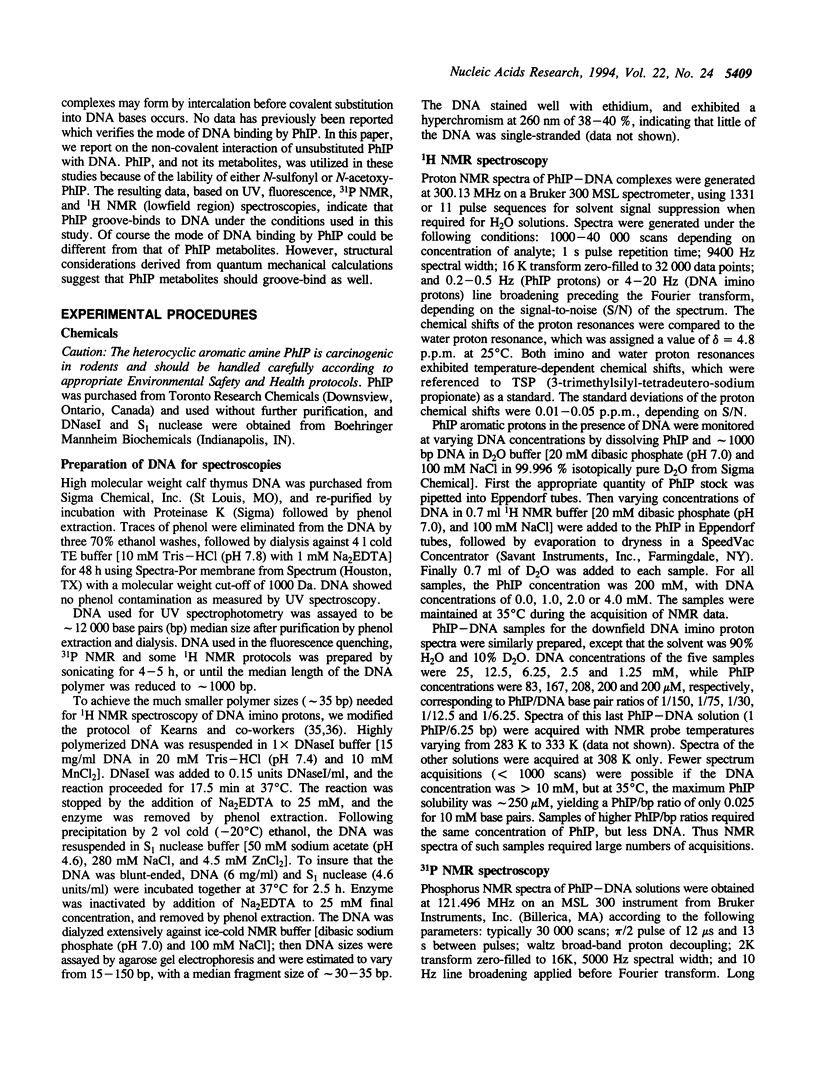
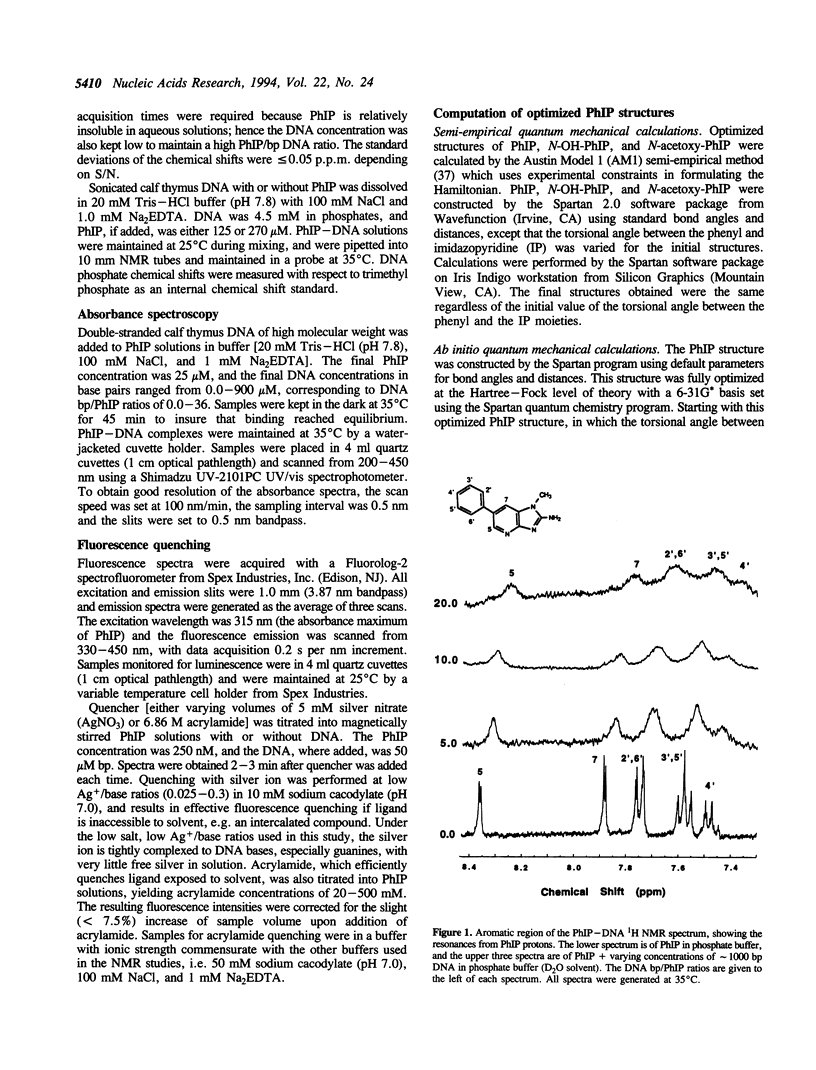
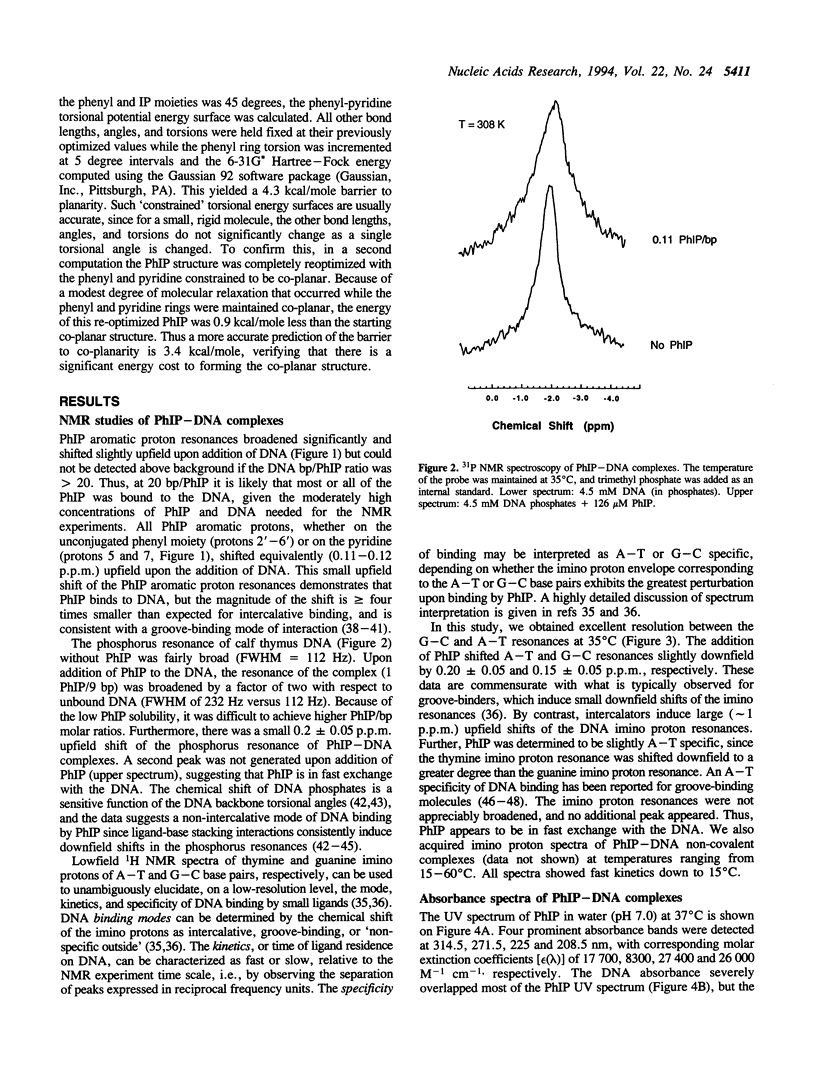
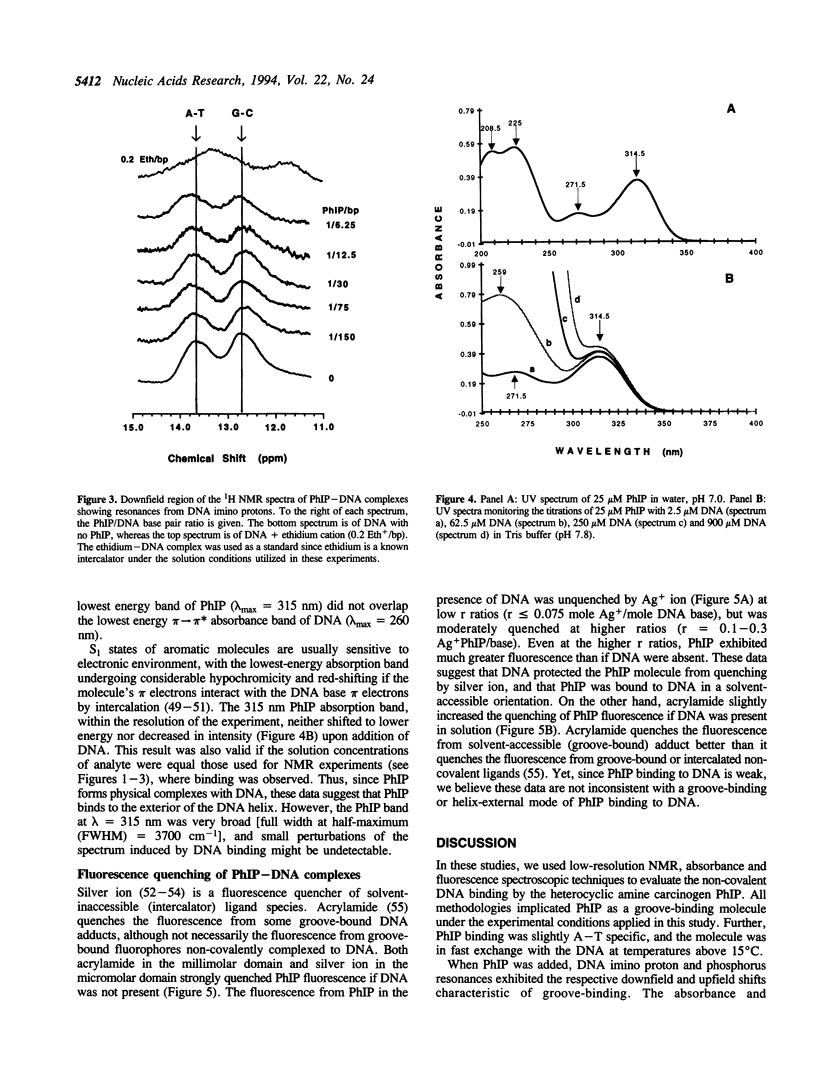
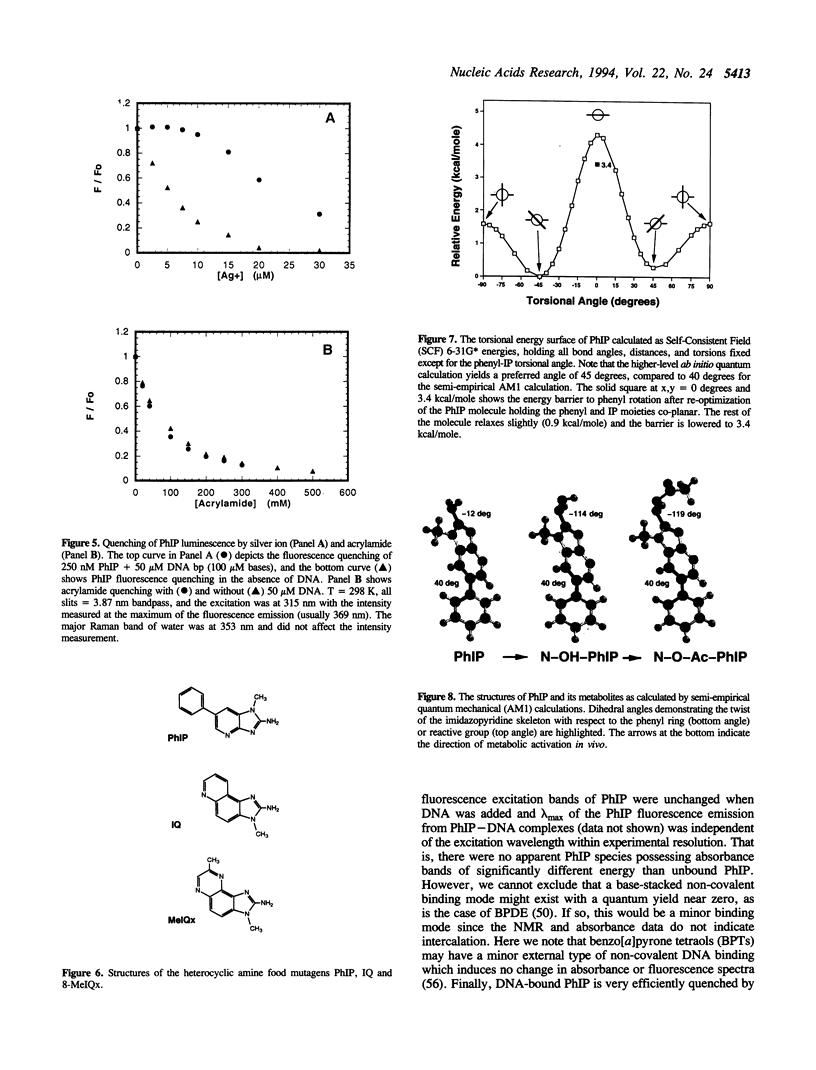
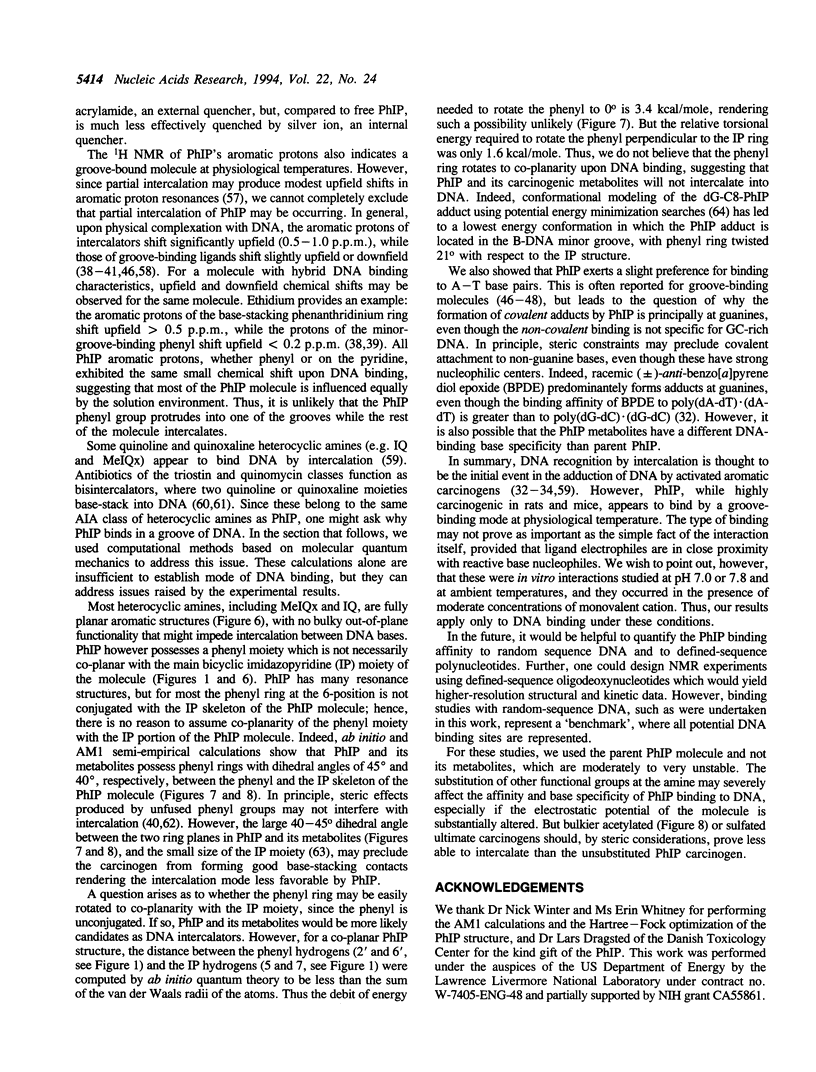
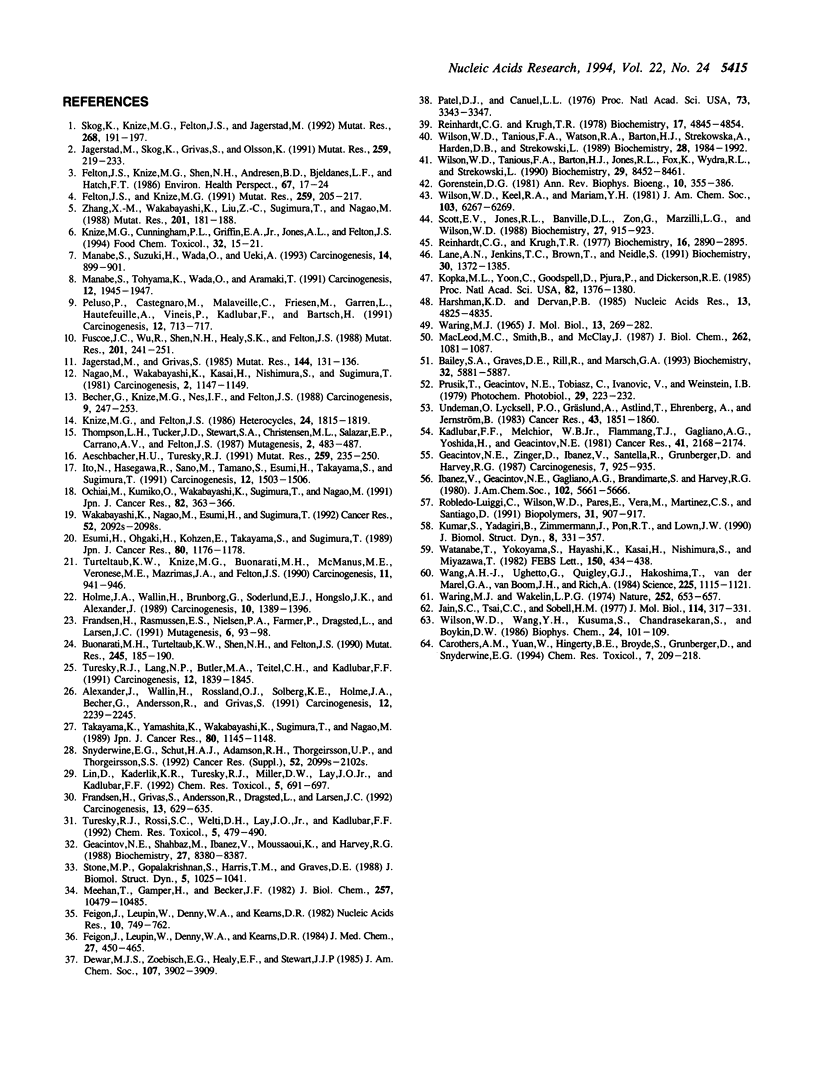
Selected References
These references are in PubMed. This may not be the complete list of references from this article.
- Aeschbacher H. U., Turesky R. J. Mammalian cell mutagenicity and metabolism of heterocyclic aromatic amines. Mutat Res. 1991 Mar-Apr;259(3-4):235–250. doi: 10.1016/0165-1218(91)90120-b. [DOI] [PubMed] [Google Scholar]
- Alexander J., Wallin H., Rossland O. J., Solberg K. E., Holme J. A., Becher G., Andersson R., Grivas S. Formation of a glutathione conjugate and a semistable transportable glucuronide conjugate of N2-oxidized species of 2-amino-1-methyl-6-phenylimidazo[4,5-b]pyridine (PhIP) in rat liver. Carcinogenesis. 1991 Dec;12(12):2239–2245. doi: 10.1093/carcin/12.12.2239. [DOI] [PubMed] [Google Scholar]
- Bailey S. A., Graves D. E., Rill R., Marsch G. Influence of DNA base sequence on the binding energetics of actinomycin D. Biochemistry. 1993 Jun 8;32(22):5881–5887. doi: 10.1021/bi00073a022. [DOI] [PubMed] [Google Scholar]
- Becher G., Knize M. G., Nes I. F., Felton J. S. Isolation and identification of mutagens from a fried Norwegian meat product. Carcinogenesis. 1988 Feb;9(2):247–253. doi: 10.1093/carcin/9.2.247. [DOI] [PubMed] [Google Scholar]
- Buonarati M. H., Turteltaub K. W., Shen N. H., Felton J. S. Role of sulfation and acetylation in the activation of 2-hydroxyamino-1-methyl-6-phenylimidazo[4,5-b]pyridine to intermediates which bind DNA. Mutat Res. 1990 Nov;245(3):185–190. doi: 10.1016/0165-7992(90)90048-o. [DOI] [PubMed] [Google Scholar]
- Carothers A. M., Yuan W., Hingerty B. E., Broyde S., Grunberger D., Snyderwine E. G. Mutation and repair induced by the carcinogen 2-(hydroxyamino)-1-methyl-6-phenylimidazo[4,5-b]pyridine (N-OH-PhIP) in the dihydrofolate reductase gene of Chinese hamster ovary cells and conformational modeling of the dG-C8-PhIP adduct in DNA. Chem Res Toxicol. 1994 Mar-Apr;7(2):209–218. doi: 10.1021/tx00038a015. [DOI] [PubMed] [Google Scholar]
- Esumi H., Ohgaki H., Kohzen E., Takayama S., Sugimura T. Induction of lymphoma in CDF1 mice by the food mutagen, 2-amino-1-methyl-6-phenylimidazo[4,5-b]pyridine. Jpn J Cancer Res. 1989 Dec;80(12):1176–1178. doi: 10.1111/j.1349-7006.1989.tb01651.x. [DOI] [PMC free article] [PubMed] [Google Scholar]
- Feigon J., Denny W. A., Leupin W., Kearns D. R. Interactions of antitumor drugs with natural DNA: 1H NMR study of binding mode and kinetics. J Med Chem. 1984 Apr;27(4):450–465. doi: 10.1021/jm00370a007. [DOI] [PubMed] [Google Scholar]
- Feigon J., Leupin W., Denny W. A., Kearns D. R. Binding of ethidium derivatives to natural DNA: a 300 MHz 1H NMR study. Nucleic Acids Res. 1982 Jan 22;10(2):749–762. doi: 10.1093/nar/10.2.749. [DOI] [PMC free article] [PubMed] [Google Scholar]
- Felton J. S., Knize M. G. Occurrence, identification, and bacterial mutagenicity of heterocyclic amines in cooked food. Mutat Res. 1991 Mar-Apr;259(3-4):205–217. doi: 10.1016/0165-1218(91)90118-6. [DOI] [PubMed] [Google Scholar]
- Felton J. S., Knize M. G., Shen N. H., Andresen B. D., Bjeldanes L. F., Hatch F. T. Identification of the mutagens in cooked beef. Environ Health Perspect. 1986 Aug;67:17–24. doi: 10.1289/ehp.866717. [DOI] [PMC free article] [PubMed] [Google Scholar]
- Frandsen H., Grivas S., Andersson R., Dragsted L., Larsen J. C. Reaction of the N2-acetoxy derivative of 2-amino-1-methyl-6-phenylimidazo[4,5-b]pyridine (PhIP) with 2'-deoxyguanosine and DNA. Synthesis and identification of N2-(2'-deoxyguanosin-8-yl)-PhIP. Carcinogenesis. 1992 Apr;13(4):629–635. doi: 10.1093/carcin/13.4.629. [DOI] [PubMed] [Google Scholar]
- Frandsen H., Rasmussen E. S., Nielsen P. A., Farmer P., Dragsted L., Larsen J. C. Metabolic formation, synthesis and genotoxicity of the N-hydroxy derivative of the food mutagen 2-amino-1-methyl-6-phenylimidazo (4,5-b) pyridine (PhIP). Mutagenesis. 1991 Jan;6(1):93–98. doi: 10.1093/mutage/6.1.93. [DOI] [PubMed] [Google Scholar]
- Fuscoe J. C., Wu R., Shen N. H., Healy S. K., Felton J. S. Base-change analysis of revertants of the hisD3052 allele in Salmonella typhimurium. Mutat Res. 1988 Sep;201(1):241–251. doi: 10.1016/0027-5107(88)90131-5. [DOI] [PubMed] [Google Scholar]
- Geacintov N. E., Shahbaz M., Ibanez V., Moussaoui K., Harvey R. G. Base-sequence dependence of noncovalent complex formation and reactivity of benzo[a]pyrene diol epoxide with polynucleotides. Biochemistry. 1988 Nov 1;27(22):8380–8387. doi: 10.1021/bi00422a013. [DOI] [PubMed] [Google Scholar]
- Geacintov N. E., Zinger D., Ibanez V., Santella R., Grunberger D., Harvey R. G. Properties of covalent benzo[a]pyrene diol epoxide-DNA adducts investigated by fluorescence techniques. Carcinogenesis. 1987 Jul;8(7):925–935. doi: 10.1093/carcin/8.7.925. [DOI] [PubMed] [Google Scholar]
- Gorenstein D. G. Nucleotide conformational analysis by 31P nuclear magnetic resonance spectroscopy. Annu Rev Biophys Bioeng. 1981;10:355–386. doi: 10.1146/annurev.bb.10.060181.002035. [DOI] [PubMed] [Google Scholar]
- Harshman K. D., Dervan P. B. Molecular recognition of B-DNA by Hoechst 33258. Nucleic Acids Res. 1985 Jul 11;13(13):4825–4835. doi: 10.1093/nar/13.13.4825. [DOI] [PMC free article] [PubMed] [Google Scholar]
- Holme J. A., Wallin H., Brunborg G., Søderlund E. J., Hongslo J. K., Alexander J. Genotoxicity of the food mutagen 2-amino-1-methyl-6-phenylimidazo[4,5-b]pyridine (PhIP): formation of 2-hydroxamino-PhIP, a directly acting genotoxic metabolite. Carcinogenesis. 1989 Aug;10(8):1389–1396. doi: 10.1093/carcin/10.8.1389. [DOI] [PubMed] [Google Scholar]
- Ito N., Hasegawa R., Sano M., Tamano S., Esumi H., Takayama S., Sugimura T. A new colon and mammary carcinogen in cooked food, 2-amino-1-methyl-6-phenylimidazo[4,5-b]pyridine (PhIP). Carcinogenesis. 1991 Aug;12(8):1503–1506. doi: 10.1093/carcin/12.8.1503. [DOI] [PubMed] [Google Scholar]
- Jain S. C., Tsai C. C., Sobell H. M. Visualization of drug-nucleic acid interactions at atomic resolution. II. Structure of an ethidium/dinucleoside monophosphate crystalline complex, ethidium:5-iodocytidylyl (3'-5') guanosine. J Mol Biol. 1977 Aug 15;114(3):317–331. doi: 10.1016/0022-2836(77)90253-4. [DOI] [PubMed] [Google Scholar]
- Jägerstad M., Grivas S. The synthesis and mutagenicity of the 3-ethyl analogues of the potent mutagens IQ, MeIQ, MeIQx and its 3,7-dimethyl isomer. Mutat Res. 1985 Nov;144(3):131–136. doi: 10.1016/0165-7992(85)90128-9. [DOI] [PubMed] [Google Scholar]
- Jägerstad M., Skog K., Grivas S., Olsson K. Formation of heterocyclic amines using model systems. Mutat Res. 1991 Mar-Apr;259(3-4):219–233. doi: 10.1016/0165-1218(91)90119-7. [DOI] [PubMed] [Google Scholar]
- Kadlubar F. F., Melchior W. B., Jr, Flammang T. J., Gagliano A. G., Yoshida H., Geacintov N. E. Structural consequences of modification of the oxygen atom of guanine in DNA by the carcinogen N-hydroxy-1-naphthylamine. Cancer Res. 1981 Jun;41(6):2168–2174. [PubMed] [Google Scholar]
- Knize M. G., Cunningham P. L., Griffin E. A., Jr, Jones A. L., Felton J. S. Characterization of mutagenic activity in cooked-grain-food products. Food Chem Toxicol. 1994 Jan;32(1):15–21. doi: 10.1016/0278-6915(84)90031-0. [DOI] [PubMed] [Google Scholar]
- Kopka M. L., Yoon C., Goodsell D., Pjura P., Dickerson R. E. The molecular origin of DNA-drug specificity in netropsin and distamycin. Proc Natl Acad Sci U S A. 1985 Mar;82(5):1376–1380. doi: 10.1073/pnas.82.5.1376. [DOI] [PMC free article] [PubMed] [Google Scholar]
- Kumar S., Yadagiri B., Zimmermann J., Pon R. T., Lown J. W. Sequence specific molecular recognition and binding by a GC recognizing Hoechst 33258 analogue to the decadeoxyribonucleotide d-[CATGGCCATG]2: structural and dynamic aspects deduced from high field 1H-NMR studies. J Biomol Struct Dyn. 1990 Oct;8(2):331–357. doi: 10.1080/07391102.1990.10507809. [DOI] [PubMed] [Google Scholar]
- Lane A. N., Jenkins T. C., Brown T., Neidle S. Interaction of berenil with the EcoRI dodecamer d(CGCGAATTCGCG)2 in solution studied by NMR. Biochemistry. 1991 Feb 5;30(5):1372–1385. doi: 10.1021/bi00219a030. [DOI] [PubMed] [Google Scholar]
- Lin D., Kaderlik K. R., Turesky R. J., Miller D. W., Lay J. O., Jr, Kadlubar F. F. Identification of N-(Deoxyguanosin-8-yl)-2-amino-1-methyl-6-phenylimidazo [4,5-b]pyridine as the major adduct formed by the food-borne carcinogen, 2-amino-1-methyl-6-phenylimidazo[4,5-b]pyridine, with DNA. Chem Res Toxicol. 1992 Sep-Oct;5(5):691–697. doi: 10.1021/tx00029a016. [DOI] [PubMed] [Google Scholar]
- MacLeod M. C., Smith B., McClay J. Equilibrium binding of derivatives of the carcinogen, benzo(a)pyrene, to DNA. Thermodynamic analysis. J Biol Chem. 1987 Jan 25;262(3):1081–1087. [PubMed] [Google Scholar]
- Manabe S., Suzuki H., Wada O., Ueki A. Detection of the carcinogen 2-amino-1-methyl-6-phenylimidazo[4,5-b]pyridine (PhIP) in beer and wine. Carcinogenesis. 1993 May;14(5):899–901. doi: 10.1093/carcin/14.5.899. [DOI] [PubMed] [Google Scholar]
- Manabe S., Tohyama K., Wada O., Aramaki T. Detection of a carcinogen, 2-amino-1-methyl-6-phenylimidazo[4,5-b]pyridine (PhIP), in cigarette smoke condensate. Carcinogenesis. 1991 Oct;12(10):1945–1947. doi: 10.1093/carcin/12.10.1945. [DOI] [PubMed] [Google Scholar]
- Meehan T., Gamper H., Becker J. F. Characterization of reversible, physical binding of benzo[a]pyrene derivatives to DNA. J Biol Chem. 1982 Sep 10;257(17):10479–10485. [PubMed] [Google Scholar]
- Nagao M., Wakabayashi K., Kasai H., Nishimura S., Sugimura T. Effect of methyl substitution on mutagenicity of 2-amino-3-methylimidazo[4,5-f]quinoline, isolated from broiled sardine. Carcinogenesis. 1981;2(11):1147–1149. doi: 10.1093/carcin/2.11.1147. [DOI] [PubMed] [Google Scholar]
- Ochiai M., Ogawa K., Wakabayashi K., Sugimura T., Nagase S., Esumi H., Nagao M. Induction of intestinal adenocarcinomas by 2-amino-1-methyl-6-phenylimidazo[4,5-b]pyridine in Nagase analbuminemic rats. Jpn J Cancer Res. 1991 Apr;82(4):363–366. doi: 10.1111/j.1349-7006.1991.tb01855.x. [DOI] [PMC free article] [PubMed] [Google Scholar]
- Patel D. J., Canuel L. L. Ethidium bromide-(dC-dG-dC-dG)2 complex in solution: intercalation and sequence specificity of drug binding at the tetranucleotide duplex level. Proc Natl Acad Sci U S A. 1976 Oct;73(10):3343–3347. doi: 10.1073/pnas.73.10.3343. [DOI] [PMC free article] [PubMed] [Google Scholar]
- Peluso M., Castegnaro M., Malaveille C., Friesen M., Garren L., Hautefeuille A., Vineis P., Kadlubar F., Bartsch H. 32P Postlabelling analysis of urinary mutagens from smokers of black tobacco implicates 2-amino-1-methyl-6-phenylimidazo[4,5-b]pyridine (PhIP) as a major DNA-damaging agent. Carcinogenesis. 1991 Apr;12(4):713–717. doi: 10.1093/carcin/12.4.713. [DOI] [PubMed] [Google Scholar]
- Prusik T., Geacintov N. E., Tobiasz C., Ivanovic V., Weinstein I. B. Fluorescence study of the physico-chemical properties of a benzo(a)pyrene 7,8-dihydrodiol 9,10-oxide derivative bound covalently to DNA. Photochem Photobiol. 1979 Feb;29(2):223–232. doi: 10.1111/j.1751-1097.1979.tb07043.x. [DOI] [PubMed] [Google Scholar]
- Reinhardt C. G., Krugh T. R. A comparative study of ethidium bromide complexes with dinucleotides and DNA: direct evidence for intercalation and nucleic acid sequence preferences. Biochemistry. 1978 Nov 14;17(23):4845–4854. doi: 10.1021/bi00616a001. [DOI] [PubMed] [Google Scholar]
- Reinhardt C. G., Krugh T. R. Phosphorus-31 nuclear magnetic resonance studies of actinomycin D, ethidium bromide, and 9-aminoacridine complexes with dinucleotides. Biochemistry. 1977 Jun 28;16(13):2890–2895. doi: 10.1021/bi00632a014. [DOI] [PubMed] [Google Scholar]
- Robledo-Luiggi C., Wilson W. D., Pares E., Vera M., Martinez C. S., Santiago D. Partial intercalation with DNA of peptides containing two aromatic amino acids. Biopolymers. 1991 Jun;31(7):907–917. doi: 10.1002/bip.360310710. [DOI] [PubMed] [Google Scholar]
- Scott E. V., Jones R. L., Banville D. L., Zon G., Marzilli L. G., Wilson W. D. 1H and 31P NMR investigations of actinomycin D binding selectivity with oligodeoxyribonucleotides containing multiple adjacent d(GC) sites. Biochemistry. 1988 Feb 9;27(3):915–923. doi: 10.1021/bi00403a012. [DOI] [PubMed] [Google Scholar]
- Skog K., Knize M. G., Felton J. S., Jägerstad M. Formation of new heterocyclic amine mutagens by heating creatinine, alanine, threonine and glucose. Mutat Res. 1992 Aug;268(2):191–197. doi: 10.1016/0027-5107(92)90224-p. [DOI] [PubMed] [Google Scholar]
- Snyderwine E. G., Schut H. A., Adamson R. H., Thorgeirsson U. P., Thorgeirsson S. S. Metabolic activation and genotoxicity of heterocyclic arylamines. Cancer Res. 1992 Apr 1;52(7 Suppl):2099s–2102s. [PubMed] [Google Scholar]
- Stone M. P., Gopalakrishnan S., Harris T. M., Graves D. E. Carcinogen-nucleic acid interactions: equilibrium binding studies of aflatoxins B1 and B2 with DNA and the oligodeoxynucleotide d(ATGCAT)2. J Biomol Struct Dyn. 1988 Apr;5(5):1025–1041. doi: 10.1080/07391102.1988.10506447. [DOI] [PubMed] [Google Scholar]
- Takayama K., Yamashita K., Wakabayashi K., Sugimura T., Nagao M. DNA modification by 2-amino-1-methyl-6-phenylimidazo[4,5-b]pyridine in rats. Jpn J Cancer Res. 1989 Dec;80(12):1145–1148. doi: 10.1111/j.1349-7006.1989.tb01644.x. [DOI] [PMC free article] [PubMed] [Google Scholar]
- Thompson L. H., Tucker J. D., Stewart S. A., Christensen M. L., Salazar E. P., Carrano A. V., Felton J. S. Genotoxicity of compounds from cooked beef in repair-deficient CHO cells versus Salmonella mutagenicity. Mutagenesis. 1987 Nov;2(6):483–487. doi: 10.1093/mutage/2.6.483. [DOI] [PubMed] [Google Scholar]
- Turesky R. J., Lang N. P., Butler M. A., Teitel C. H., Kadlubar F. F. Metabolic activation of carcinogenic heterocyclic aromatic amines by human liver and colon. Carcinogenesis. 1991 Oct;12(10):1839–1845. doi: 10.1093/carcin/12.10.1839. [DOI] [PubMed] [Google Scholar]
- Turesky R. J., Rossi S. C., Welti D. H., Lay J. O., Jr, Kadlubar F. F. Characterization of DNA adducts formed in vitro by reaction of N-hydroxy-2-amino-3-methylimidazo[4,5-f]quinoline and N-hydroxy-2-amino-3,8-dimethylimidazo[4,5-f]quinoxaline at the C-8 and N2 atoms of guanine. Chem Res Toxicol. 1992 Jul-Aug;5(4):479–490. doi: 10.1021/tx00028a005. [DOI] [PubMed] [Google Scholar]
- Turteltaub K. W., Knize M. G., Buonarati M. H., McManus M. E., Veronese M. E., Mazrimas J. A., Felton J. S. Metabolism of 2-amino-1-methyl-6-phenylimidazo[4,5-b] pyridine (PhIP) by liver microsomes and isolated rabbit cytochrome P450 isozymes. Carcinogenesis. 1990 Jun;11(6):941–946. doi: 10.1093/carcin/11.6.941. [DOI] [PubMed] [Google Scholar]
- Undeman O., Lycksell P. O., Gräslund A., Astlind T., Ehrenberg A., Jernström B., Tjerneld F., Nordén B. Covalent complexes of DNA and two stereoisomers of benzo(a)pyrene 7,8-dihydrodiol-9,10-epoxide studied by fluorescence and linear dichroism. Cancer Res. 1983 Apr;43(4):1851–1860. [PubMed] [Google Scholar]
- Wakabayashi K., Nagao M., Esumi H., Sugimura T. Food-derived mutagens and carcinogens. Cancer Res. 1992 Apr 1;52(7 Suppl):2092s–2098s. [PubMed] [Google Scholar]
- Wang A. H., Ughetto G., Quigley G. J., Hakoshima T., van der Marel G. A., van Boom J. H., Rich A. The molecular structure of a DNA-triostin A complex. Science. 1984 Sep 14;225(4667):1115–1121. doi: 10.1126/science.6474168. [DOI] [PubMed] [Google Scholar]
- Waring M. J. Complex formation between ethidium bromide and nucleic acids. J Mol Biol. 1965 Aug;13(1):269–282. doi: 10.1016/s0022-2836(65)80096-1. [DOI] [PubMed] [Google Scholar]
- Waring M. J., Wakelin L. P. Echinomycin: a bifunctional intercalating antibiotic. Nature. 1974 Dec 20;252(5485):653–657. doi: 10.1038/252653a0. [DOI] [PubMed] [Google Scholar]
- Watanabe T., Yokoyama S., Hayashi K., Kasai H., Nishimura S., Miyazawa T. DNA-binding of IQ, Me-IQ and Me-IQx, strong mutagens found in broiled foods. FEBS Lett. 1982 Dec 27;150(2):434–438. doi: 10.1016/0014-5793(82)80784-9. [DOI] [PubMed] [Google Scholar]
- Wilson W. D., Tanious F. A., Barton H. J., Jones R. L., Fox K., Wydra R. L., Strekowski L. DNA sequence dependent binding modes of 4',6-diamidino-2-phenylindole (DAPI). Biochemistry. 1990 Sep 11;29(36):8452–8461. doi: 10.1021/bi00488a036. [DOI] [PubMed] [Google Scholar]
- Wilson W. D., Tanious F. A., Watson R. A., Barton H. J., Strekowska A., Harden D. B., Strekowski L. Interaction of unfused tricyclic aromatic cations with DNA: a new class of intercalators. Biochemistry. 1989 Mar 7;28(5):1984–1992. doi: 10.1021/bi00431a005. [DOI] [PubMed] [Google Scholar]
- Wilson W. D., Wang Y. H., Kusuma S., Chandrasekaran S., Boykin D. W. The effect of intercalator structure on binding strength and base-pair specificity in DNA interactions. Biophys Chem. 1986 Jul;24(2):101–109. doi: 10.1016/0301-4622(86)80003-5. [DOI] [PubMed] [Google Scholar]
- Zhang X. M., Wakabayashi K., Liu Z. C., Sugimura T., Nagao M. Mutagenic and carcinogenic heterocyclic amines in Chinese cooked foods. Mutat Res. 1988 Sep;201(1):181–188. doi: 10.1016/0027-5107(88)90124-8. [DOI] [PubMed] [Google Scholar]


